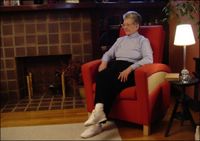Robot Chair to Assist Elderly
From Discovery Channel News:
Robot Technology Creates Easy Chair
By Tracy Staedter, Discovery News
pril 21, 2005 — A new chair may help keep elderly people happy, healthy and active.
The SenseChair prototype, developed by a team of researchers and designers at Carnegie Mellon University, uses robotic technology to monitor the sitter's behavior and respond accordingly.
Research on the SenseChair started with a two-year study that identified 55 opportunities for using technology in the home.
The team was comprised of people from a range of disciplines, including social scientists, production and interactive designers, and mechanical and software engineers.
Using expertise from their own fields, in addition to feedback collected from focus groups, the team created a high-tech product that didn't intimidate seniors.

Sensechair
"We feel that for elders, who are our first audience, the metal man is probably not the right model," said assistant professor of design and human-computer interaction Jodi Forlizzi, who heads the SenseChair team.
The result is a therapeutic chair that looks like something out of a design catalog.
The shape is contemporary and the fabric is cheery and modern. But imbedded within are sensors, motors, sounds, lights and computer and wireless technology that keep track of the senior's habits and react when something happens out of the ordinary.
For example, 12 sensors in the chair identify vital signs, sleep patterns and the person's normal level of activity.
If the senior stays in one position too long, any of the 14 motors located throughout the chair will gently rouse the elder to shift positions.
Sounds such as voice or music can be programmed to wake the person from a nap. And if the senior awakes during the evening, eight lights beneath the chair help illuminate the way.
Ideally, the chair would be part of an electronic network in an elder care community, and could alert caregivers or even medical personnel if a vital sign or normal activity pattern fell below normal.
This summer, the team will be conducting in-home trials to put the chair and their collaborative approach to test.
The chair not only represents a new way of assisting an aging population, but is one example of the university's effort to integrate style and technology into a product that also connects with values.
"If engineers would have designed it, it probably would have looked like an electric chair," said Craig Vogel, director of the center for Design Research and Innovation at the University of Cincinnati.
According to Vogel, robotics research at many universities still tends to be rooted in technology and not design. Engineers first develop a technological solution to some problem and then the designers come in later to retrofit it as a product.
Discovery Channel :: News :: Robot Technology Creates Easy Chair
Robot Technology Creates Easy Chair
By Tracy Staedter, Discovery News
pril 21, 2005 — A new chair may help keep elderly people happy, healthy and active.
The SenseChair prototype, developed by a team of researchers and designers at Carnegie Mellon University, uses robotic technology to monitor the sitter's behavior and respond accordingly.
Research on the SenseChair started with a two-year study that identified 55 opportunities for using technology in the home.
The team was comprised of people from a range of disciplines, including social scientists, production and interactive designers, and mechanical and software engineers.
Using expertise from their own fields, in addition to feedback collected from focus groups, the team created a high-tech product that didn't intimidate seniors.

Sensechair
"We feel that for elders, who are our first audience, the metal man is probably not the right model," said assistant professor of design and human-computer interaction Jodi Forlizzi, who heads the SenseChair team.
The result is a therapeutic chair that looks like something out of a design catalog.
The shape is contemporary and the fabric is cheery and modern. But imbedded within are sensors, motors, sounds, lights and computer and wireless technology that keep track of the senior's habits and react when something happens out of the ordinary.
For example, 12 sensors in the chair identify vital signs, sleep patterns and the person's normal level of activity.
If the senior stays in one position too long, any of the 14 motors located throughout the chair will gently rouse the elder to shift positions.
Sounds such as voice or music can be programmed to wake the person from a nap. And if the senior awakes during the evening, eight lights beneath the chair help illuminate the way.
Ideally, the chair would be part of an electronic network in an elder care community, and could alert caregivers or even medical personnel if a vital sign or normal activity pattern fell below normal.
This summer, the team will be conducting in-home trials to put the chair and their collaborative approach to test.
The chair not only represents a new way of assisting an aging population, but is one example of the university's effort to integrate style and technology into a product that also connects with values.
"If engineers would have designed it, it probably would have looked like an electric chair," said Craig Vogel, director of the center for Design Research and Innovation at the University of Cincinnati.
According to Vogel, robotics research at many universities still tends to be rooted in technology and not design. Engineers first develop a technological solution to some problem and then the designers come in later to retrofit it as a product.
Discovery Channel :: News :: Robot Technology Creates Easy Chair

0 Comments:
Post a Comment
Subscribe to Post Comments [Atom]
<< Home